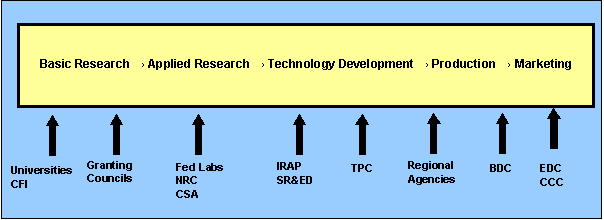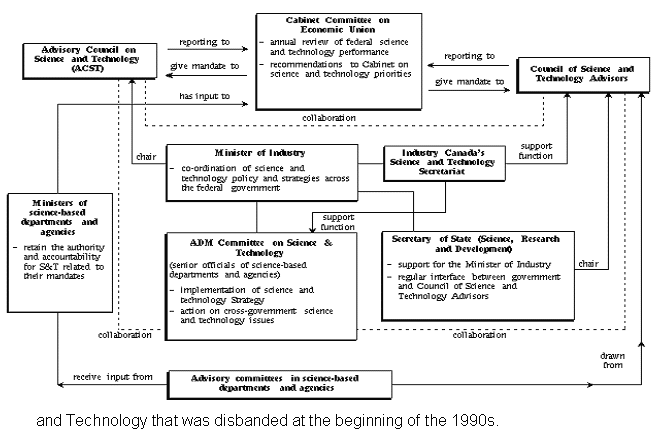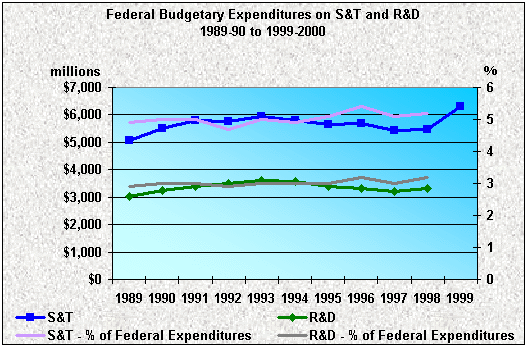INST Committee Report
If you have any questions or comments regarding the accessibility of this publication, please contact us at accessible@parl.gc.ca.
CHAPTER 4: THE INNOVATION POLICY FRAMEWORK
The public good (non-rivalrous) and non-exclusive (non-proprietary) nature of basic research, and some applied or project research, means that the innovator cannot appropriate all of the benefits associated with his or her invention. Without recourse to other institutional responses that would overcome the market’s failure to adequately capture these spillover benefits as a reward to the innovator, governments were encouraged to consider actively stepping in and providing incentives and funding to restore a healthier level of R&D. Long-standing public policy was certainly simple given this rationale: we should be looking for the areas of research that have the largest spillover effects and fund the R&D work either directly through intramural government facilities or by provision of subsidy to the private R&D performer, or indirectly through the tax system. Although this seems relatively straightforward, it turns out that, in many cases, other institutional responses have in fact been open and available to the private sector.
Our work has shown that spillovers exist and that an awful lot of them, in the academic jargon, are internalized: firms operate networks that effectively internalize spillovers [and] allow them to extract the benefits for themselves. They find efficient ways to make markets work. But not all knowledge is protectable in that way. We have as a society looked at areas where we perceive that it is very difficult to internalize those spillovers. [John Baldwin; 13, 9:50]
These findings suggest that policy based on the traditional linear view of innovation (basic research?applied research?patenting (sometimes)?technology development? commercialization?production?marketing), which was heavily focused on basic research due to the much larger appropriability problem associated with this activity, was not as effective as one had previously thought and that other strategic pursuits might be more rewarding. Moreover, there were also practical lessons to be learned from past public policy initiatives:
[L]ooking at the history of policy and programs in support of science and technology — both in Canada and in other countries — it’s extremely important not to push technological information and scientific information into the business community. What works best is to build up the capacity of business and the demand that business has for that information. I think there are too many programs that have failed, both in Canada and in other countries, that have been based on the premise that we simply provide business with information about new technological developments or simply build up a research capacity in this country and then expect business to pick that information up. Well, business has a lot of patents sitting in its files. … What’s important is to build up the receptor capability within businesses and their ability to not only develop new products but also invest in new enabling technologies. [Jayson Myers; 13, 9:35]
Though perhaps this overstates the case when we consider the plight of small business:
When we then turn to look at other problems which have to do with information difficulties, information on foreign markets, information on new technologies, information that is obtained by collaborative exercises with other firms, small firms tell us those are major problems, large firms don’t. Large firms are good ingesters of information. That’s why they get large. They develop systems to obtain information. [John Baldwin; 13, 10:00]
These and other discoveries convinced the S&T community to shift the emphasis of public policy away from the government being a performer of R&D, as well as attempting to pick between "winners and losers" when subsidizing private R&D projects, towards the government being a catalyst, facilitator and strategic investor of R&D.
I say we have to keep investing with our partners, universities and companies, but especially given that universities have new tools, new levers, it will be much easier for them to work with companies, and companies will be able to make better use of tax breaks if they do more work with universities. It enhances both, and both are crucial. [The Honourable Gilbert Normand; 9, 9:45]
The S&T community had thus come to realize the futility in trying to pick the "technology winners," preferring instead that the winners emerge on the basis of their creative skills and business acumen within a strengthened innovation infrastructure. In this context, the public policy approach has been to invest in the innovation infrastructure, not individual performers, while attempting to bridge the talents and activities of different institutions engaged in the innovation process. Partnership initiatives and leverage funding thus became the operative direction of federal S&T strategy in the last half of the 1990s, as systemic failures, rather than market failures, became the principal hurdle to overcome.
More formally, the federal government began to take a new strategic direction as set forth in its 1996 publication: Science and Technology for the New Century — A Federal Strategy. On the basis of this strategy, the government set out three goals for the federal investment in S&T:
to ensure that Canada is among the best in the world in applying and commercializing S&T for sustainable job creation and economic growth;
to ensure that Canada applies S&T to improve the quality of life for our citizens through the creation of fulfilling jobs and through the most effective social, environmental and health care programs in the world; and
to create in Canada world centres of excellence in scientific discovery, to build a broad base of scientific enquiry, to foster Canadian participation in all major fields of science and technology, and to ensure that new knowledge can be acquired and disseminated widely from Canadian sources and from around the world.
This federal strategy provides direction to departments and agencies, and sets out the elements of a federal governance structure for their S&T activities. The strategy document was further accompanied by action plans for departments and agencies involved in S&T. While simplifying the role of each government agent or program, Figure 4.1 positions each along the innovation continuum according to the strategy’s design.
Figure 4.1
Government
Agents and Programs on the Innovation Continuum

Source: Technology Partnerships Canada, Industry Canada.
Finally, in the Throne Speech of 2001, the federal government committed itself to making Canada one of the top five most innovative countries in the world by 2010.
The "culture of innovation" is therefore a social project, and its success will, of course, depend on the collaboration of all stakeholders. Here again, we have every reason to be proud. Our researchers are among the most productive in the world, both in terms of the number of research-related publications and the level of international co-operation they have to their credit. These results prove that we are on the right path, but despite this, the Canadian government is fostering much more ambitious projects. We are determined to rank fifth in the world for investment in research and development by 2010. … It is in this context that the Canadian government has promised to double its own expenditure on research and development by 2010. [The Honourable Gilbert Normand; 9, 9:10]
The government intends to partner with provincial/territorial governments, businesses, educational institutions and individual Canadians to realize this goal. More specifically, the government has committed to:
at least doubling federal expenditures on R&D;
strengthening the research capacity of Canadian universities and government laboratories and institutions;
accelerating Canada’s ability to commercialize research discoveries;
pursuing a global strategy for Canadian science and technology (S&T);
strategically targeting new investments in research (e.g. in life sciences); and
increasing support for the development of new technologies to assist Canadians with disabilities.
The Committee believes that the doubling of federal expenditures on R&D, should it leverage private sector spending by traditional amounts, is a tall order that would have Canada’s GERD-to-GDP ratio approach 3% and would definitely put Canada in the top five R&D performers of the world, holding everything else constant. However, the facts are that everything else is very unlikely to be the same; other countries are also likely to significantly increase their government expenditures on R&D over the next decade to ensure their successful transition to a knowledge-based economy. Indeed, the Committee was made aware that:
Many other nations have also set ambitious R&D goals, with some countries such as Sweden and Finland already on target to reach 4% by 2010. As other countries are not standing still, … R&D investment in Canada will need to triple to place Canada near or among the top five OECD countries … by 2010. [Robert Giroux, Association of Universities and Colleges of Canada; 23, 9:30]
While the Committee supports the federal government’s R&D funding goal, it nevertheless has two misgivings with the above goals and fiscal commitments. First, the Committee believes that the objective of being one of the top five R&D performers is too narrowly focused. A broader approach that would encompass target goals of intermediate inputs to innovation, such as scientific publications and resident patent applications, should be included. Although the Committee understands that the government does not have direct control over these outputs of R&D, it is not without some influence. Because it is outcomes and not inputs that matter when it comes to innovation, the Committee recommends:
4. That the Government of Canada target the number of scientific publications (per 100,000 population) and resident patent applications (per 10,000 population), which are surrogate measures of scientific discoveries and technological innovation, respectively, produced and processed each year in Canada. Canada’s relative performance should be benchmarked — and government policy should be assessed — on these terms against comparable countries of the world.
The Committee also believes that the government’s fiscal commitments to implementing its strategy omit a couple of key ingredients. There is little or no new commitment to the improvement of technology development and diffusion. Although later chapters will discuss this issue in greater detail, the Committee recommends:
5. That the Government of Canada pledge its support and commitment to improved technology development and diffusion, particularly amongst Canadian small and medium-sized businesses.
Federal Governance: S&T Advice, Decision Making and Management
In the course of its S&T review, which began in 1994, the federal government decided to make a number of changes to the structure and processes of its decision-making. The Cabinet Committee on Economic Union (CCEU) was given the mandate to review the performance of federal S&T activities on an annual basis and to recommend priorities to Cabinet. To facilitate its review of S&T priorities, the CCEU is to receive advice from a new body, the Advisory Council on Science and Technology. The Council — which is composed of 12 eminent Canadians who represent academic, voluntary and industry stakeholders — replaces the National Advisory Board on Science and Technology that was disbanded at the beginning of the 1990s.
Exhibit 4.1
Federal
Science and Technology Management Regime

Source: 1998 Annual Report of the Auditor General of Canada.
The improvement of top-level advisory and decision-making structures is not enough to ensure that the Canadian innovation system would yield best results, however. The government also recognized that an improvement in the management of its investment would also be required, which, first and foremost, necessitated more coordination of intramural S&T activities among federal agencies, as well as greater collaboration on major horizontal issues — those that cut across departmental and agency boundaries. This coordination function resides with the Minister of Industry and the Secretary of State (Science, Research and Development), who are supported by another new body, the Council of Science and Technology Advisors, comprising 22 advisors from outside government and chaired by the Secretary of State. Exhibit 4.1 provides a schematic of the decision-making structure and reporting lines concerning S&T activities in the federal government.
The present federal governance structure for S&T has a number of deficiencies related to overall coordination and the addition of the increasing number of councils has worsened the situation. This issue and a possible solution used in other countries were well presented by the Secretary of State (Science, Research and Development).
I would like to point out that, at present, the scientific sectors are very diversified. We have sectoral departments that conduct their own research such as, for example, Agriculture and Agri-Food, Fisheries and Oceans, Natural Resources, Environment and Industry, and it is very difficult to have what I would call an umbrella or some type of control over all these activities, so that there are some departments that do this job better than others, there are some that make less of an effort. I do not want to exaggerate the situation, but we know that this problem exists within the government apparatus.
With the emergence of all of these granting councils, it is going to become increasingly difficult for sectoral ministers to oversee all of these activities. In the future, if we want to supervise, to some extent, the activities, not only of the granting councils, but also of the sectoral departments that do research, I think that we are going to have to obtain authorization from Cabinet or from the Prime Minister’s Office. …
At the present time we have a committee known as the Committee of Science and Technology Experts, whose meetings I attend, but what I want to point out is that several countries have set up systems. In the United States, Japan, Germany and Britain there is, at the level of the Prime Minister’s Office, a scientific advisor and there is often a science minister who is not necessarily a sectoral minister but rather a minister whose mandate covers all such activities throughout the government in all areas. [The Honourable Gilbert Normand; 9, 9:24]
Given the importance of maintaining a coordinated and cohesive federal role in S&T, the Committee recommends:
6. That the Government of Canada review its current governance structure for federal science and technology and transform the Secretary of State (Science, Research and Development) to a Minister of Science and Technology responsible for overall federal science and technology issues and programs.
The Committee is also of the view that there is merit in further exploring the creation of a Science and Technology Advisory Body, or modification of the current Advisory Council on Science and Technology that reports to the Prime Minister, that would report to Parliament. Indeed, the Committee intends to pursue this governance issue in greater detail in its next S&T report.
In fiscal year 1999-2000, the federal government spent more than $6.3 billion on S&T (see Table 4.1). Intramural expenditures amounted to $3.3 billion, while extramural expenditures were at an all-time high of $3 billion; the growth of the latter being largely attributable to the CFI. Of this latter $3 billion, more than one third is allocated to Canadian business enterprises, $1.6 billion to Canadian higher education, $240 million to foreign S&T performers, $98 million to private non-profit institutions, and $33 million to other Canadian S&T performers, including provincial and municipal governments.
Table 4.1
Federal S&T Expenditures by Department/Agency in Fiscal Year 1999-2000
Institution |
Amount |
Institution |
Amount |
Federal Departments: Agriculture and Agri-Food Canada Environment Canada Fisheries and Oceans Canada Health Canada Industry Canada National Defence Canada Natural Resources Canada Statistics Canada Other* |
310 424 205 225 411 553 359 419 668 |
Federal Agencies: Atomic Energy of Canada Limited CIDA Canada Space Agency IDRC Canadian Institute for Health Research National Research Council Canada NSERC SSHRC Canada Foundation for Innovation Total |
120 347 306 81 309 305 540 121 605 6,308 |
* Consolidates data of 39 federal departments and agencies, including Parks Canada, HRDC, DFAIT, the CFIA and Transport Canada.
Source: Statistics Canada. 1999. Science Statistics, Cat. No. 88-001-XIB, October 1999.
Figure 4.2 provides us with another perspective of federal expenditures on S&T and R&D. It indicates the federal government’s commitment to its new innovation agenda over the last decade. Recalling from Chapter 2 that Canada’s GERD-to-GDP fluctuated about 1.5% but managed an increase to somewhat more than 1.6% by the end of the decade, federal government gross expenditures on R&D has fluctuated about 3% of total government expenditures, also ending at an all-time high of 3.2%. The absolute dollar figures present a slightly different story, having peaked in 1993 at $3.59 billion before the federal government began its deficit reduction plan. While the trajectory of R&D expenditures was initially downward until its bottom was reached at $3.19 billion in 1997, the federal government’s commitment to R&D is demonstrated by the fact that other expenditures were held more in check than those on R&D. The higher priority assigned to innovation is also confirmed in the S&T data. The absolute dollar figures spent by the federal government on S&T were down from its peak of $5.95 billion in 1993, bottoming out at $5.45 billion in 1997. At $6.3 billion in 1999, representing an average annual increase of 7.5% over the last two years of the decade, these expenditures are one of the fastest growing items in the federal government’s budget.
Figure 4.2

Source: Statistics Canada and Finance Canada.
The data also confirm the new strategic approach taken by the federal government. Intramural R&D undertaken by the federal government represented 19% of total R&D performed in Canada, down from 29% in 1990. The business sector, followed by foreign sources, made the most inroads as an R&D performer, increasing their shares of total R&D performed from 41% to 49% and from 10% to 14%, respectively.